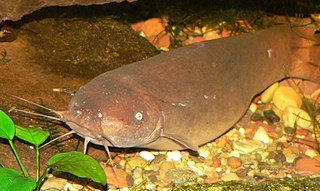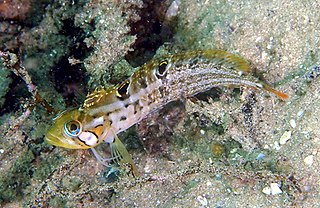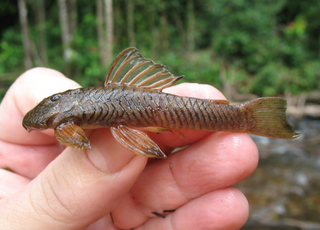
The stream catfishes comprise the family Akysidae of catfishes.

Rineloricaria is a genus of freshwater tropical catfish belonging to the family Loricariidae. They are commonly called whiptail catfish because of the long filament that grows out of the tip of the caudal fin that is characteristic of the genus. With the exception of R. altipinnis from Panama, they are native to the rivers of northern and central South America. Some species are regularly seen in the aquarium trade.

Malapterurus is a genus of catfishes of the electric catfish family (Malapteruridae). It includes 18 species.

Bagarius is an Asian genus of catfishes of the family Sisoridae. It includes five to six extant species and potentially one extinct fossil species, B. gigas.

Acrochordonichthys is a genus of catfishes of the family Akysidae. It includes ten species.

Synodontis granulosus is a species of upside-down catfish endemic to the Democratic Republic of the Congo, Burundi, Zambia, and Tanzania, where it is only known from Lake Tanganyika. It was first described by Belgian-British zoologist George Albert Boulenger in 1900, from specimens collected at multiple points along the shore of Lake Tanganyika. The species name comes from the Latin word "granulum", meaning of grain, and refers to the granular papillae present on the skin of the fish's body.

Synodontis petricola, known as the cuckoo catfish, or the pygmy leopard catfish, is a species of upside-down catfish endemic to Burundi, Zambia, the Democratic Republic of the Congo, and Tanzania where it is only known from Lake Tanganyika. It was first described by Belgian ichthyologist Hubert Matthes in 1959. The species name "petricola" is derived from a combination of the Latin petra, meaning stone or rock, and the Latin cola, meaning inhabitant. This refers to the rocky environment where this species is found.
Acrochordonichthys falcifer is a species of catfish of the family Akysidae. It' is known only from the Kinabatangan and Segama River drainages, and possibly from the Kayan River drainage, in north-eastern Borneo. A. falcifer falls into the second species group of its genus—the A. rugosus section. It includes A. falcifer, A. chamaeleon, A. pachyderma, and A. rugosus.
Breitensteinia insignis is a species of catfish of the family Akysidae. A detailed discussion of this species's relationship with the other species in the genus can be found at Breitensteinia.

Malapterurus beninensis is a species of electric catfish native to the African nations of Angola, Benin, Cameroon, the Democratic Republic of the Congo, the Republic of the Congo, Equatorial Guinea, Gabon, Ghana, Nigeria and Togo. This species grows to a length of 22 cm (9 in) SL. Its habitat is lowland marshes, rivers, and lakes.
Microsynodontis notata is a species of upside-down catfish endemic to Gabon where it occurs in the Ogowe River. It was first described in 2004 by Ng Heok Hee.

Synodontis grandiops is a species of upside-down catfish endemic to the Democratic Republic of the Congo, Burundi, and Tanzania, where it is only known from Lake Tanganyika. It was first described by Jeremy John Wright and Lawrence M. Page in 2006, from specimens collected at multiple points along the shore of Lake Tanganyika. The species name is a Latinized combination of the Latin "grandi", meaning large or big, and the Greek "ops", meaning eye, a reference to the relatively large eyes of this fish.
Climacoporus navalis, the fleet klipfish, is a species of clinid found in subtropical waters of the Atlantic Ocean along the coast of South Africa where it can be found in tide pools. This species can reach a maximum length of 7 centimetres (2.8 in) TL. It is currently the only known member of its genus.
Clinus brevicristatus, the Cape klipfish, is a species of clinid that occurs in subtropical waters of the Atlantic Ocean around South Africa where it prefers habitats with plentiful growth of seaweed. This species can reach a maximum length of 12 centimetres (4.7 in) TL.

Clinus venustris, the speckled klipfish, is a species of clinid that occurs in subtropical waters of the Atlantic Ocean from Namibia to South Africa where it is found in the subtidal zone as well as being a denizen of tide pools. This species can reach a maximum length of 12 centimetres (4.7 in) TL. and feeds primarily on amphipods, isopods, mysids, and echinoderms.
Synodontis irsacae is a species of upside-down catfish endemic to Zambia, the Democratic Republic of the Congo, and Tanzania, where it is only known from Lake Tanganyika. It was first described by Belgian ichthyologist Hubert Matthes in 1959, from specimens collected from Lake Tanganyika at Kalundu, in what is now the Democratic Republic of the Congo. The species name " irsacae" is derived from the abbreviation "I.R.S.A.C.", or Institut pour la Recherche Scientifique en Afrique Centrale. For many years, specimens of the species were considered to be juvenile members of S. dhonti, but in 2006, J.J. Wright and L.M. Page identified unique characteristics of this species that established that they were a unique species.

Guyanancistrus nassauensis is a species of catfish belonging to the family Loricariidae, the suckermouth armored catfishes. It is discovered in 2005 and formally described in 2018. G. nassauensis is a rare species, highly endemic to the Nassau Mountains in Suriname, and is threatened with extinction by proposed or ongoing mining activities.
Schistura scripta, is a species of ray-finned fish in the genus Schistura, newly identified from Sri Lanka. It is the third species of Schistura stone loach described from Sri Lanka, the other being the widely distributed native species Schistura notostigma and endemic Schistura madhavai.
Yaluwak is a genus of armored catfish native to South America where they are only known from Guyana, containing only a single species Yaluwak primus. It was first described in a 2020 study and placed within the tribe Ancistrini.

Rhinogobius brunneus, the common freshwater or the Amur goby, is a complex of several species in the family Oxudercidae. It is found in the Asian river basins of the seas of the Pacific coasts of Japan, Taiwan, the rivers of Korea, China, the Philippines, and Vietnam.










